|
|
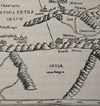 |
==Ptolemy
sees India as
a mountain-bordered triangle (c.90-168): Living in the sophisticated
city
of Alexandria, in Egypt, the great geographer Ptolemy (*Henry
Davis*) produces, among numerous other works, the view of Asia
depicted
in this map, including a very schematic India. (Here's how the
Ptolemaic
world fits together: *Columbia
U.*.) Considering the information available to him, his achievement
is impressive, and his influence on later mapmakers lasts for centuries.
|
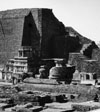 |
==Nalanda,
the famous Buddhist "university" in Bihar (c.100? on till 1100's?).
Buddhist
tradition says that Nalanda was founded even during the lifetime of the
Buddha, and was visited by him. The existing Buddhist structures at the
site, however, come from the 500's and later; the site is also full of
Hindu and Jain temples. It seems very possible that by the 100's
Nalanda
may have existed in some form. Images of its later phases: *DSAL*. [*Routes*] |
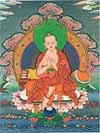 |
==Nagarjuna
(c.100's), in South India, formulates the Buddhist philosophical
doctrine
of Madhyamika, or the "Middle Way" (*kalachakra*);
he is a uniquely influential South Asian Buddhist thinker, and his
doctrines
shape an important part of Tibetan Buddhism (*wikipedia*).
He is traditionally associated with Nalanda. |
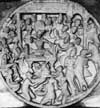 |
==Amaravati
(c.100's), in Andhra, with its magnificent huge stupa and lavish
decoration,
becomes one of the wonders of its time. (By now, alas, after
centuries
of digging by treasure-seekers, only gorgeous fragments remain.)
Images:
*DSAL*;
IGNCA: *01*,
*02*,
*03*,
*04*. |
 |
==Kanheri,
near Bombay (c.100's): the earliest stupas and other material from a
site
that continued to be developed for centuries. Images: *DSAL*;
*Berger*. [*Routes*] |
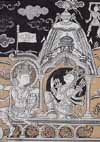 |
==the
Bhagavad Gita becomes part (c.100?) of the steadily
developing
Mahabharata, and the career is launched that will eventually make it
the
single most popular text of modern Hinduism (*Columbia
Univ.*). The story of how Krishna persuades Arjuna to fight in a
fratricidal
war proves to have a lasting hold on people's religious imaginations. [*Routes*] |
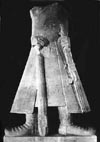 |
==Kanishka
and his inscriptions (c.110?): Kanishka, the greatest
Kushan
emperor, is also the most Indianized. Like others of the *Kushan
dynasty* (*asianart*),
he is a patron of sculpture. In this image, a Sanskritic inscription on
his robe reads: "King of kings (maharajadhiraja), great king
(maharaja),
son of god (devaputra), Kanishka." His two capital cities are Mathura
and
Peshawar; this statue is from a temple near Mathura. In one inscription
he refers to his language, Bactrian (*N.
Sims-Williams*), as "an Aryan language." [*Routes*] |
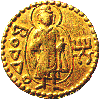 |
==Kanishka's
Buddhist coins: Kanishka becomes
a notable
patron of Buddhism (*nupam*),
and is the first ruler to use an image of the Buddha on coins (like
this
one, with its Kharoshthi inscription). The traditional Indian dating
system
(*web
exhibits*) is named for the Shaka (or Saka) and starts in 78 CE;
some
consider that Kanishka initiated this system. The dates of Kanishka's
own
reign, however, have proved particularly hard to determine: dates
between
78 and 128 have been proposed (*Keele*),
but no consensus has yet been reached. [*Routes*] |
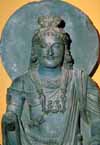 |
=="Gandharan"
Kushan art in full flower (c.110-300): After the emperor
Kanishka becomes a champion of Buddhism, his patronage and that of
later
Kushan rulers help create and perpetuate the widespread, long-lived
"Gandhara
school" (*wiki*;
*Univ.
of Alabama*) of Greek-influenced sculpture (*gandhara*);
one of its later stylistic centers is in Mathura, the Kushans' eastern
capital, which develops a style of its own. More examples of
Gandharan/Kushan
sculpture: *IGNCA*; *ANU*.
([Routes*] |
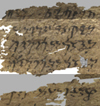 |
==The
earliest Buddhist manuscripts: The earliest known
Buddhist
manuscripts, written in Kharoshthi script, come from Gandhara, and date
from this period. Only a few have yet been translated (*Univ.
of Washington*). By now Buddhism has also begun to spread along the
famous "Silk Road" (*silk
road*) caravan route. |
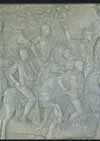 |
==Trajan
weeps as he turns back from
the road to India (c.115): The Roman emperor Trajan (*roman
emperors*), like many of his precedessors, has great ambitions as a
conqueror in the east. His earlier campaigns against the Dacians are
celebrated
in a magnificent Forum in Rome, crowned by the famous Trajan's Column (*cheiron*).
His final conquests during the Parthian War extend the Roman Empire as
far east as it is ever destined to go. When his armies triumphantly
reach
the Persian Gulf, Trajan weeps, because he is too old to continue
eastward
to India as Alexander did. He dies on the way home, in 117, and his
successor
Hadrian abandons all the new eastern conquests. |
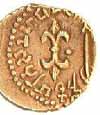 |
==Nahapana (c.105-25):
Around this time, the *Western
Kshatrapas*, who have been acting as Pahlava satraps, drive the
Satavahana
dynasty from the northwest part of the Deccan. Their most famous early
king is called Nahapana, and his coins continue the hybrid tradition:
Greek
on one side, Brahmi (*ancient
scripts*) or Kharoshthi (*ancient
scripts*) on the other. Study materials: *Ancient
Coins Canada* (search for "Nahapana") |
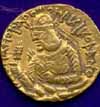 |
==Huvishka, another
Kushan king (c.126-64), is a successor of Kanishka's during the heyday
of the *Kushan
dynasty*; he builds monuments in Mathura, Kashmir, and Afghanistan.
He circulates some of the most beautiful and varied coins of any of the
early kings; they feature images of Greek, Zoroastrian, and Hindu
deities:
*nupam*.
[*Routes*] |
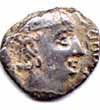 |
==Rudradaman's
Sanskrit (c.130-55?): The emperor Rudradaman, one of
Nahapana's
successors among the *Western
Kshatrapas*, governs much of Rajasthan and Sind. An inscription at
Junagarh dated to the year 150 describes his martial glories and his
reconstruction
of a great artificial lake in Girnar that had been excavated under
Chandragupta
and improved by Ashoka. This inscription is the earliest significant
inscription
in full-fledged Sanskrit that has yet been found (*MSSU*;
*Imperial
Gazetteer*). Study materials: *Ancient
Coins Canada* (search for "Rudradamana") |
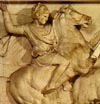 |
==Arrian's
Anabasis describes Alexander's Indian experiences
(c.150):
Lucius Flavius Arrianus, known as Arrian, composes the best history of
Alexander that we have. It is called "Anabasis" ("the March
Up-country"),
and its Book VIII, "Indica" (*Internet
Sourcebook*), is a thoughtful, sophisticated account of India
itself
and Alexander's experiences there. This bas-relief of Alexander (in
battle,
as usual) is taken from the marble sarcophagus in which his body lay. |
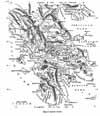 |
==Pausanias
(fl.c.150-80), a prolific chronicler (*perseus*),
mostly writes about Greece, but makes occasional remarks on India: how
the Greeks import ivory from India, and find the elephant fascinating;
and how the Indians (and the Chaldeans) were the first to say that the
soul was immortal; and other such things: *perseus*. |
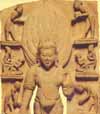 |
==the
Laws of Manu ("Manu-smriti," or "Manava dharma shastra")
appears (c.100's-200's): This most famous of the "dharma shastra"
(religious
law) works has been vastly influential in defining later Hinduism,
including
the caste system (*Internet
Sourcebook*; *sacred
texts*). When the Dalits (the "untouchables" confined to the
ritually
polluted sub-basement of the system) began to organize against caste
abuses,
one of their first symbolic acts (1927) was to burn the "Laws of Manu." |
|
|


















